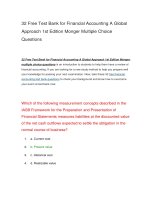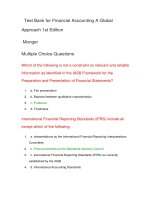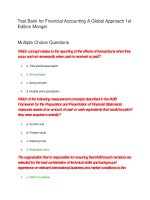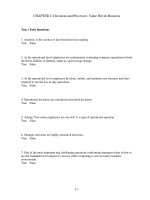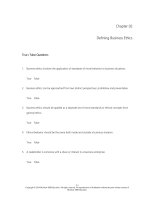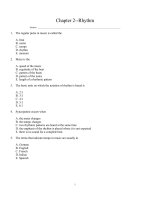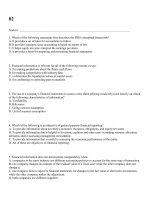Financial accounting a critical approach CANADIAN 4th edition john friedlan test bank
Bạn đang xem bản rút gọn của tài liệu. Xem và tải ngay bản đầy đủ của tài liệu tại đây (4.42 MB, 81 trang )
02
Student: ___________________________________________________________________________
1. Which of the following statements best describes the IFRS conceptual framework?
A. It provides a set of rules for accountants to follow.
B. It provides concepts, since accounting is based on nature of law.
C. It helps equity investors interpret the earnings per share.
D. It provides a basis for preparing and presenting financial statements.
2. Financial information is relevant for all of the following reasons except:
A. for making predictions about the future cash flows
B. for making comparisons with industry data.
C. to determine the liquidation values of capital assets
D. for confirming or correcting past evaluations.
3. The use of a company's financial statements to assess a new share offering would rely most heavily on which
of the following characteristics of information?
A. Verifiability
B. Relevance
C. Going concern assumption
D. Unit of measure assumption
4. Which of the following is an objective of general purpose financial reporting?
A. To provide information about an entity's economic resources, obligations, and equity/net assets.
B. To provide information that is helpful to investors, creditors and other users in making resource allocation
decisions and/or assessing management stewardship.
C. To provide information that is useful in assessing the economic performance of the entity.
D. All of these are objectives of financial reporting.
5. Financial information does not demonstrate comparability when:
A. companies in the same industry use different accounting policies to account for the same type of transaction.
B. one company changes its estimate of the residual value of a fixed asset while the other company does not
change it.
C. one company fails to adjust its financial statements for changes in the fair value of short term investments,
while the other company makes the adjustment.
D. both companies use different suppliers.
6. The transition to International Financial Reporting Standards can be seen as enhancing which of the
following qualitative characteristics?
A. Verifiability
B. Comparability
C. Understandability
D. Timeliness
7. Anvilles Inc. manufactures metal sheets for construction. Mr. Anvilles, the sole shareholder, arranges to
transport two hundred metal sheets to the family cottage in Mont Orford. He tells the bookkeeper to record the
cost of the metal sheets as cost of goods sold.
Which of the following qualitative characteristics of accounting information has not been respected?
A. Both verifiability and the entity concept
B. Both the unit of measure assumption and faithful representation
C. Both faithful representation and the entity concept
D. Both relevance and the unit of measure assumption
8. Mr. Switch, a local business man, owns two different businesses—a lumber sawmill and a restaurant. The
price of lumber has declined and therefore sawmill is in financial difficulty. However, the restaurant is thriving,
and Mr. Switch would like to start paying two of the sawmill employees under the restaurant's payroll. His
accountant explains that this is not in accordance with certain basic principles in accounting. Which principle is
he referring to?
A. Full disclosure
B. Periodic-reporting assumption
C. Entity concept
D. Unit-of-measure assumption
9. One drawback to the unit-of-measure assumption is:
A. it inhibits an assessment of going concern.
B. information about individual items being measured is lost.
C. it makes it easier to measure certain assets, such as intellectual property, human capital, and social costs.
D. it makes it harder to measure transactions.
10. The assumption that a business enterprise will not be sold or liquidated in the near future is known as the:
A. entity concept.
B. unit-of-measure assumption.
C. going-concern assumption.
D. periodic-reporting assumption.
11. When assessing general purpose financial statements, the financial analyst takes into consideration the fact
that many important assets may not be included in the company's statement of financial position, such as human
resource capital, intellectual property and social responsibility. This limitation is the result of applying which of
the following characteristics of financial information?
A. Entity concept
B. Unit-of-measure assumption
C. Going-concern assumption
D. Periodic-reporting assumption
12. Which of the following statements about general purpose financial statements is correct?
A. General purpose financial statements are designed to meet the information needs of
B. every stakeholder in every situation.
C. General purpose financial statements provide information to all stakeholders.
D. General purpose financial statements are intended for specific use only.
E. The financial statements of non-public companies are general purpose financial statements.
13. How often do companies prepare general purpose financial statements?
A. At least once a year.
B. Only when asked for by a stakeholder.
C. Every time management needs to make a financial decision.
D. As often as GAAP requires.
14. The best description of the financial statements that a public company prepares is:
A. tax-based financial statements.
B. specific purpose financial statements.
C. general principle financial statements.
D. general purpose financial statements.
15. General purpose financial statements include which of the following sets of statements?
A. Balance statement, income statement, statement of long-term debt, cash flow statement
B. Balance sheet, income statement, statement of shareholders' equity, cash flow statement
C. Balance sheet, income statement, statement of shareholders' equity, statement of long-term debt
D. Balance statement, income statement, statement of retained earnings, cash balance
16. What does the term "consolidated" mean when used to describe financial statements?
A. Consolidated means that financial statements are presented for two years.
B. Consolidated means that the financial statements have been approved by an auditor.
C. Consolidated means that the five financial statements have been totalled together.
D. Consolidated means that the financial statements contain the information of more than one company.
17. Sun Company owns 75% of Moon Inc., how would Sun's financial statements be prepared?
A. On a consolidated basis.
B. On a specific purpose basis.
C. On a subsidiary basis.
D. On a financial basis.
18. Why are financial statements prepared on a comparative basis?
A. To provide users with easy comparison with the industry.
B. To provide users with a perspective on the economy.
C. Because making comparisons using accounting information can be difficult and misleading.
D. Because making comparisons significantly contributes to the interpretation of accounting information.
19. Which of the following statements about a fiscal year is true?
A. It is the same for all companies in the same industry.
B. It is the financial accounting term used to describe the calendar year.
C. It is a 12-month period ending any time in the calendar year.
D. It is the period covered by the balance sheet.
20. Which financial statement is a snapshot at a point in time?
A. Balance sheet
B. Income statement
C. Statement of changes in equity
D. Cash flow statement
21. Which of the following statements best describes the balance sheet?
A. It provides information about the financial position of an entity at a specific point in time.
B. It measures the economic performance of the entity over a period of time.
C. It summarizes only the changes to retained earnings during a period.
D. It shows how an entity managed its cash during the reporting period.
22. Which of the following statements best describes the statement of comprehensive income?
A. It provides information about the financial position of an entity at a specific point in time.
B. It measures economic events that involve non-owners but affect equity.
C. It summarizes the changes to shareholders' equity during a period.
D. It is an extension of the balance sheet.
23. Which of the following statements best describes the income statement?
A. It provides information about the financial position of an entity at a specific point in time.
B. It measures the economic performance of the entity over a period of time.
C. It summarizes the changes to retained earnings during a period.
D. It shows how an entity managed its cash during the reporting period.
24. Which of the following statements best describes the Statement of Changes in Equity?
A. It provides information about the financial position of an entity at a specific point in time.
B. It measures the economic performance of the entity over a period of time.
C. It summarizes the changes to shareholders' equity during a period.
D. It shows how an entity managed its cash during the reporting period.
25. Which of the following statements best describes the cash flow statement?
A. It provides information about the financial position of an entity at a specific point in time.
B. It measures the economic performance of the entity over a period of time.
C. It summarizes the changes to retained earnings during a period.
D. It shows how an entity managed its cash during the reporting period.
26. Which of the following statements about the cash flow statement is true?
A. The cash flow statement reports what the net income would be if the cash basis of accounting had been
followed.
B. The cash flow statement deals with cash, an asset; therefore, the cash flow statement is a snapshot statement
just like the balance sheet.
C. The cash flow statement does not have to be included in general purpose financial statements.
D. The cash flow statement shows how the company managed its money for the period from more than just
operations.
27. The bookkeeper at Walin Ltd. has prepared a list of all the property, plant and equipment the company
owns, including their original cost to the company and how much has been depreciated to date. Where will this
information most likely be included in the company's general purpose financial statements?
A. On the balance sheet.
B. In the cash flow statement.
C. In the notes to the financial statements.
D. This information will not be included in the company's general purpose financial statements.
28. Brantford Business Ltd. (BBL) has a loan outstanding from a Canadian bank. It uses the loan to finance its
working capital. The bank has asked for BBL to provide it with monthly listings of their accounts receivables
and inventory items. The requested listing is an example of:
A. a special purpose report.
B. a general purpose report.
C. a balance sheet report.
D. a cash flow report.
29. What is the accounting equation?
A. Assets + Liabilities = Owners' Equity
B. Assets = Liabilities - Owners' Equity
C. Assets = Liabilities + Owners' Equity
D. Assets + Owners' Equity = Liabilities
30. In 2012, Smith's Corner Store had an increase in gross margin of $28,000; however, the gross margin
percentage decreased. This is most likely caused by:
A. a decrease in volume and a decrease in selling price
B. an increase in volume and an increase in selling price.
C. an increase in volume and a decrease in selling price.
D. a decrease in volume and an increase in selling price.
31. Mats owns and operates a small advertising business from an office. His home is worth $400,000, his
business assets are worth $275,000, and his business obligations total $65,000. How much equity does he have
in his advertising business?
A. $210,000
B. $335,000
C. $340,000
D. $610,000
32. Whitefish Inc. bought a building worth $750,000. They paid $150,000 in cash and borrowed the remainder
from a bank. What is the effect of this transaction on the accounting equation?
A. Assets increases by $750,000 and liabilities increases by $750,000.
B. Assets increases by $750,000 and liabilities increases by $660,000.
C. Assets increases by $600,000 and liabilities increases by $750,000.
D. Assets increases by $600,000 and liabilities increases by $600,000.
33. Trout Co. ordered and received inventory worth $45,000 on credit. What is the effect of this transaction on
the accounting equation?
A. Assets increases by $45,000 and liabilities increases by $45,000.
B. Assets increases by $45,000 and liabilities decreases by $45,000.
C. Assets decreases by $45,000 and liabilities increases by $45,000.
D. Assets decreases by $45,000 and liabilities decreases by $45,000.
34. A shareholder invested $75,000, made up of $50,000 in cash and a vehicle worth $25,000, in a new
company and received shares in exchange. What is the effect of this transaction on the accounting equation?
A. Assets increases by $75,000 and owners' equity increases by $75,000.
B. Assets increases by $75,000 owners' equity increases by $50,000, and liabilities increases by $25,000.
C. Assets increases by $50,000 and owners' equity increases by $50,000.
D. Assets increases by $50,000 and liabilities increases by $50,000.
35. Sam's Snow Removal received $500 at the beginning of the winter to cover the fees for the entire winter for
cleaning a customer's driveway while they went to Florida for the season. What is the effect of this transaction
on the accounting equation?
A. Assets increases by $500 and owners' equity increases by $500.
B. Assets increases by $500 and liabilities increases by $500.
C. Liabilities increases by $500 and owners' equity increases by $500.
D. The increase and decrease in assets offset each other.
36. If an entity pays off an amount owed to a supplier, what is the effect on the accounting equation?
A. Assets and liabilities both increase.
B. Assets and liabilities both decrease.
C. Assets and owners' equity both decrease
D. There is no effect on the accounting equation.
37. If an entity receives cash from a customer for payment of an amount owing to them, what is the effect on the
accounting equation?
A. Assets and liabilities both increase.
B. Assets and liabilities both decrease.
C. Assets and owners' equity both decrease
D. There is no effect on the accounting equation.
38. If a company pays rent for the next period in advance, what is the effect of the transaction on the accounting
equation?
A. Assets decrease, and liabilities decrease.
B. Assets decrease, and owners' equity decrease.
C. Assets increase, and liabilities increase.
D. There is no effect on the accounting equation.
39. Which of the following correctly describes an asset?
A. An obligation of the entity
B. An investment the owners have made
C. An economic resource that provides future benefits
D. An economic sacrifice made to earn revenue
40. Which of the following correctly describes a liability?
A. An obligation of the entity
B. An investment the owners have made
C. An economic resource that provides future benefits
D. An economic sacrifice made to earn revenue
41. Which of the following would be considered as an asset for accounting purposes?
A. Employees who work for the company
B. Research into new products for the company
C. A building owned by the company but rented out
D. Advertising spent on attracting customers to the company
42. Which of the following is a non-current asset?
A. Accounts receivable
B. Inventory
C. Prepaid rent
D. Intangible assets
43. Which of the following statements about current liabilities is true?
A. Current liabilities are always less than current assets.
B. Current liabilities are amounts from non-operating activities only.
C. Current liabilities will be paid or satisfied within an operating cycle.
D. Current liabilities are legal obligations of the company.
44. Pike Ltd. bought a new delivery truck for its business. The truck sells for $75,000, because Pike bought a
demonstrator model, they paid $65,000 only. While driving it home from the sales lot, the driver had an
accident, and damages were estimated at $1,000. At what value should the truck be recorded on Pike's statement
of financial position?
A. $64,000
B. $65,000
C. $66,000
D. $75,000
45. What are direct investments by shareholders in a company called?
A. Dividends
B. Capital stock
C. Retained earnings
D. Investments
46. What is a payment of cash to a corporation's shareholders called?
A. A liability
B. A dividend
C. A deficit
D. An expense
47. Which of the following is an indirect investment by a shareholder?
A. The cash paid for shares.
B. A plot of land exchanged for shares.
C. The net income retained by the company.
D. The dividends paid to shareholders.
48. What does the term "deficit" mean in the context of general purpose financial statements?
A. A deficit is when the net income is negative.
B. A deficit is when the retained earnings balance is negative.
C. A deficit is when the current liabilities exceed the current assets.
D. A deficit is when a company borrows money.
49. Which of the following statements about the payment of dividends is true?
A. They are reported in the cash from operations.
B. They are reported in the cash from financing activities.
C. They are reported in the cash from investing activities.
D. They are reported as an expense on the income statement.
50. If a company made a principal repayment on a long-term loan, which of the following statements about the
repayment is true?
A. It is reported in the cash from operations.
B. It is reported in the cash from financing activities.
C. It is reported in the cash from investing activities.
D. It is reported as an expense on the income statement.
51. Which of the following statements about an operating cycle is true?
A. For all businesses the operating cycle is a year or less.
B. The operating cycle is useful in defining current assets.
C. The operating cycle is the difference between revenues and operating expenses.
D. An operating cycle is the time it takes from the sale of inventory until the collection of cash.
52. Which of the following industries would most likely have an operating cycle longer than a year?
A. A grocery store
B. A wine producer
C. A soft drinks producer
D. A car manufacturer
53. Which of the following would be classified as inventory?
A. Cars in the fleet of a car rental company
B. Cars in the fleet of a pizza delivery company
C. Land held for expansion by a retail company
D. Land on which a retail company owns a building
54. Which of the following is not a liability?
A. The amount owing to a supplier
B. A warranty sold with a product
C. The amount owing for next month's rent
D. A cash deposit received on a sale for next month
55. Which of the following correctly describes an expense?
A. An obligation of the entity.
B. An investment the owners have made in the business.
C. An economic resource that provides future benefits.
D. An economic sacrifice made to earn revenue.
56. Bass Ltd. borrowed $100,000 from a bank. They will repay $10,000 a year for the next ten years plus 5%
interest. How would the loan be initially recorded on Bass's statement of financial position?
A. $100,000 non-current liability
B. $100,000 current liability
C. $10,000 current liability and $90,000 non-current liability
D. $15,000 current liability and $90,000 non-current liability
57. Which of the following can you find in the notes to the financial statements?
A. A list of all the stakeholders of the entity.
B. A summary of the entity's significant accounting policies.
C. A summary of the special purpose reports prepared
D. Management's discussion of the results of the entity.
58. Gifts Galore is a souvenir shop. They have just paid $2,000 for the exclusive rights to sell the latest hot fad
"Talking Toads". They estimate the fad should last about six months. They also paid $250,000 to be the
exclusive carrier of Olympic souvenirs for the next four years. How would each of these intangible assets be
reported on the balance sheet?
A. Option A
B. Option B
C. Option C
D. Option D
59. Yamaska just purchased a restaurant from a company that went out of business. They are going to sell off all
the furniture, tables and chairs that came with it, because they are going to redecorate it with a new theme. How
would the building and the furniture be reported on the balance sheet?
A. Option A
B. Option B
C. Option C
D. Option D
60. Massawippi Inc. owes a supplier $10,000. They have signed a note payable for the amount, promising to
repay it in six months with interest. They also have a loan outstanding that, starting next year, they will repay in
annual instalments over the next five years. How would the note payable and the loan be reported on the
balance sheet?
A. Option A
B. Option B
C. Option C
D. Option D
61. Which of the following correctly identifies one of the links among the four financial statements?
A. Net income from the income statement goes directly to the balance sheet.
B. Net income from the income statement goes to the statement of changes in equity.
C. Other comprehensive income goes to the statement of cash flows.
D. Retained earnings from the balance sheet goes to the income statement.
62. Because of the links among financial statements, they must be prepared in order. Which of the following
correctly describes the order of preparation?
A. Income statement, statement of comprehensive income, statement of changes in equity, and balance sheet.
B. Income statement, balance sheet, statement of comprehensive income, and statement of changes in equity.
C. Balance sheet, income statement, and statement of changes in equity.
D. Balance sheet, statement of changes in equity, income statement, and statement of comprehensive income.
63. The opening balance of retained earnings for Musicala Inc. was $325,000. During the year, it earned net
income of $52,400 and paid dividends of $16,000. What is the closing balance of retained earnings?
A. $256,600
B. $309,000
C. $361,400
D. $377,400
64. The opening balance of shareholders' equity for Sedona Transport was $530,000. During the year, Sedona
issued 50,000 common shares at market price of $3.50 per share. The company earned net income of $152,400,
recorded other comprehensive income of ($2,300), and paid dividends of $10,000. What is the closing balance
of shareholders' equity?
A. $670,100
B. $847,400
C. $845,100
D. $877,400
65. Lennox Limited reported sales of $5,000,000, cost of goods sold of $3,200,000, operating expenses of
$1,400,000, and income tax expense of $160,000 for the year. What is the gross profit for the year?
A. $240,000
B. $400,000
C. $1,800,000
D. $3,200,000
66. Lennox Limited reported sales of $5,000,000, cost of goods sold of $3,200,000, operating expenses of
$1,400,000, and income tax expense of $160,000 for the year. What was their net income for the year?
A. $240,000
B. $400,000
C. $1,800,000
D. $3,200,000
67. The opening balances of capital stock and retained earnings for a company were $2,200,000 and
$1,325,000, respectively. During the year, they earned net income of $425,000, the shareholders invested an
additional $500,000 for shares and the company paid dividends of $42,000. What was the closing amount of
shareholders' equity?
A. $1,708,000
B. $2,208,000
C. $3,908,000
D. $4,408,000
68. Sherbrooke Inc. reported sales of $10,000,000, net income of $800,000, and dividends of $200,000. What is
the increase in their retained earnings for the year?
A. $600,000
B. $800,000
C. $1,000,000
D. $10,000 000
69. During the past year Ascot Company made credit sales of $450,000, cash sales of $275,000, and collected
$50,000 of deposits on future orders. What amount should they report as revenue on their income statement?
A. $275,000
B. $325,000
C. $725,000
D. $775,000
70. Today, a company sold $1,000 of goods on credit. The customer took the goods with him, but will only pay
in 30 days. When would the sale be reflected under the cash basis of accounting and the accrual basis of
accounting?
A. Option A
B. Option B
C. Option C
D. Option D
71. When a sale on credit is made under the cash basis of accounting, at the time of the sale, how is the
transaction recorded?
A. An increase in assets and an increase in liabilities
B. An increase in assets and an increase in revenues
C. An increase in liabilities and an increase in revenues
D. It is not recorded.
72. When a sale on credit is made under the accrual basis of accounting, at the time of the sale, how is the
transaction recorded?
A. An increase in assets and an increase in liabilities
B. An increase in assets and an increase in revenues
C. An increase in liabilities and an increase in revenues
D. It is not recorded.
73. Which of the following statements about depreciation is true?
A. Depreciation is the allocation of the cost of equipment to expense.
B. Depreciation represents the reduction in the market value of the asset.
C. Depreciation is the cash paid each month to use a piece of equipment.
D. Depreciation is the same under both cash-based and accrual-based accounting.
74. An employee worked for a small business during the current month but he will not be paid until the next
month. If the business uses accrual accounting, what would be the effect on the accounting equation in the
current month?
A. Assets decrease and liabilities decrease.
B. Liabilities increase and owners' equity increases.
C. Liabilities increase and owners' equity decreases.
D. There is no effect at this time.
75. An employee worked for a small business during the current month but will not be paid until the next
month. If the business uses cash accounting, what would be the effect on the accounting equation in the current
month?
A. Assets decrease and liabilities decrease.
B. Liabilities increase and owners' equity increases.
C. Liabilities increase and owners' equity decreases.
D. There is no effect at this time.
76. When a company makes a sale under accrual accounting, what is the impact on the balance sheet?
A. Assets increase
B. Assets decrease
C. Assets and owners' equity both increase
D. The increase and decrease in assets offset each other
77. If an entity suffered a $2,000 loss for the month, which of the following statements is most likely true?
A. The company's cash decreased $2,000.
B. The company's shareholders need to invest $2,000.
C. The costs incurred during the month exceeded the benefits.
D. Not all of the revenues were collected during the month.
78. Creditors who are expecting to be paid are most interested in which of the following for an entity?
A. Liquidity
B. Operating cycle
C. Gross margin
D. Profitability
79. What would a creditor calculate to assess liquidity?
A. Operating cycle
B. Gross margin
C. Current ratio
D. Debt-to-equity ratio
80. A company has current assets of $200,000 and current liabilities of $150,000. If they used cash to pay off
some accounts payable, what would the effect be on their current ratio?
A. The current ratio would increase.
B. The current ratio would decrease.
C. The current ratio would stay the same.
D. The effect on the current ratio would depend on the amount paid.
81. A company has current assets of $200,000 and current liabilities of $150,000. If they used cash to pay off
some accounts payable what would the effect be on their working capital?
A. Their working capital would increase.
B. Their working capital would decrease.
C. Their working capital would stay the same.
D. The effect on the working capital would depend on the amount paid.
82. If a company has a current ratio of 0.82, which of the following statements would be true?
A. The company is a serious credit risk and should not be lent money.
B. The company's current ratio is below the industry average.
C. The company's working capital cannot be calculated.
D. The company's working capital is negative.
83. If a stakeholder wanted to measure the risk of a company, which of the following would they calculate?
A. Liquidity
B. Operating cycle
C. Profitability
D. Debt-to-equity ratio
84. If a company used some cash and a long-term loan to buy land and a building, what would be the effect on
the company's current ratio and debt-to-equity ratio?
A. Option A
B. Option B
C. Option C
D. Option D
85. If a company used some cash to pay off some long-term liabilities, what would be the effect on the
company's current ratio and debt-to-equity ratio?
A. increase increase
B. increase decrease
C. decrease increase
D. decrease decrease
86. If a company sold shares for cash, what would be the effect on the company's current ratio and
debt-to-equity ratio?
A. Option A
B. Option B
C. Option C
D. Option D
87. If a company bought inventory on account, what would be the effect on the company's current ratio and
debt-to-equity ratio?
A. Option A
B. Option B
C. Option C
D. Option D
88. If an analyst wanted to compare the operating performance of two retail companies, which of the following
would be most useful?
A. Current ratio
B. Operating cycle
C. Debt-to-equity
D. Gross margin percentage
89. For which of the following ratios would a decrease in the ratio normally imply an improvement in the
company's performance?
A. Current ratio
B. Profitability ratio
C. Gross margin percentage
D. Debt-to-equity ratio
90. Lennox Limited reported sales of $5,000,000, cost of goods sold of $3,200,000, operating expenses of
$1,400,000, and income tax expense of $160,000 for the year. What is the gross profit percentage for the year?
A. 4.8%
B. 8%
C. 36%
D. 64%
91. Classify each of the following cash transactions as an operating, financing or investing activity:
A) wages paid to employees
B) dividends paid to shareholder
C) loan repaid to shareholder
D) purchase of office equipment
E) payment of rent
92. Classify each of the following balance sheet items as a current asset, non-current asset, current liability or
non-current liability.
A) cash
B) a 10-year loan owing to a bank
C) an amount owing to a supplier due in 30 days
D) land purchased for immediate resale by a real estate developer
E) a delivery truck
93. Classify each of the following balance sheet items as a current asset, non-current asset, current liability, or
non-current liability.
A) Dividends declared but not yet paid to shareholders
B) Wages owing to employees
C) A loan owing to a shareholder that will be repaid in two years
D) Land purchased for expansion by a retailer
E) An amount owing from a customer due in 15 months
94. Why is the cash basis of accounting not used when preparing general purpose financial statements? What is
used instead?
95. Differentiate between an asset and an expense. Use the example of a table and chairs and explain how each
could be either an asset or an expense.
96. Tim has decided to run a lawn service business for the summer. He charges customers $100 per month to
mow and maintain their lawns. In May he was able to get 10 contracts signed, for services starting June 1st. On
June 1st he collected $100 from each of seven customers and $300 from the other three, who will all be out of
town for the summer so have paid for all three months at once. Tim bought a second-hand mower for the
summer for $240, which he picked up in May but didn't pay for until June, when he had some cash available.
He estimates that it will be completely worn out by the end of the summer. He mowed and maintained the lawns
for June and paid $50 for gas for his mower.
Required:
A) What is Tim's net income for June under the cash basis of accounting?
B) What is Tim's net income for June under the accrual basis of accounting?
C) What is Tim's expected net income for the summer under the cash basis of accounting?
D) What is Tim's expected net income for the summer under the accrual basis of accounting?
E) Which method is more appropriate for Tim? Support your answer.
97. Prepare a proper balance sheet for Wawa Corporation from the following list of accounts on June 30, 2012:
98. Wasago is in its first year of operation, and the bookkeeper has prepared the following summary of all of
their accounts and balances as at August 31, 2012. Prepare a proper balance sheet for Wasago Corporation.
99. The following is a list of accounts for Carleton Corporation for the year ended October 31, 2012.
Required:
A) Prepare an income statement for Carleton for the year.
B) What is Carleton's gross margin for the year?
C) What is Carleton's gross margin percentage for the year?
100. Emily has been out of school and working as a physiotherapist for four years. She is in the process of
buying a condo and is applying for a mortgage from the Canadian Bank. The bank has asked for a personal
balance sheet for Emily before making its decision. She has come to you for help and has provided you with the
following information:
i) Emily bought a car four years ago for $15,000. She borrowed the money from her parents, interest free, and
still owes them $3,000 and makes monthly payments of $250. She estimates the car is worth about $5,000 now.
ii) Emily has $1,800 in her checking account and $12,000 in Canada Savings Bonds (CSBs), which she will use
for the down payment on the condo.
iii) Emily owns some jewellery given to her after her grandmother past away. Although it is priceless to Emily
the local jeweller says it is worth $3,500.
iv) Emily worked some overtime at another clinic over the recent holidays and is owed $2,500 for it.
v) Emily has a music player and CD collection worth about $1,000.
vi) Emily has old furniture in her current apartment that she paid $500 for but is hoping to buy some new things
to go with her new place. She hopes a charity will come and take all of the old stuff away.
vii) Emily has a $500 balance on her credit card but pays it off every month.
Required:
A) Prepare a personal balance sheet for Emily. She wants you to explain why things were or were not included
so that she could do it herself next time.
B) How will the Canadian Bank use the information to help it make a decision?
C) What, if any, other information would the bank like to have?
101. Below are partial income statements for Haliburton Ltd. for three years.
Required:
A) Fill in the missing amounts.
B) Is Haliburton's operating performance improving? Support your answer.
102. Below are partial balance sheets for Bancroft Inc. for three years.
Required:
A) Fill in the missing amounts.
B) Are Bancroft's liquidity and risk improving? Support your answer. If you were a shareholder in Bancroft,
would you be concerned?
103. Show the effect that each of the following independent transactions has on the elements of the accounting
equation. Specify the type of asset, liability or owners' equity account that would be affected.
A) Sells $100,000 worth of goods, 60% on credit, the rest for cash
B) Buys $55,000 of goods on account
C) Collects $25,000 owing from customers.
D) Makes $10,000 loan payment
E) Borrows $35,000 from shareholders
104. Show the effect that each of the following independent transactions has on the elements of the accounting
equation. Specify the type of asset, liability or owners' equity account that would be affected.
A) Employees work and earn $12,500, to be paid next week
B) Shareholder buys shares for 75,000
C) Pays $3,000 for current month's rent
D) Buys land for $15,000 cash and $85,000 loan
E) Sells $80,000 worth of goods on credit
